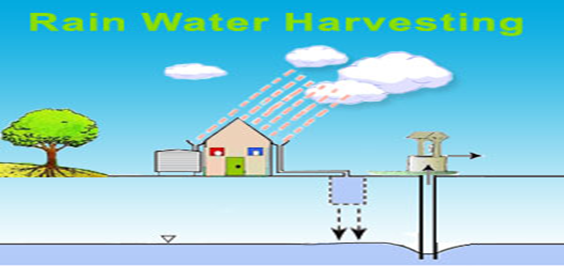Rainwater harvesting essentially means collecting rainwater on the roofs of building and storing it underground for later use. Not only does this recharging arrest groundwater depletion, it also raises the declining water table and can help augment water supply. Rainwater harvesting and artificial recharging are becoming very important issues. It is essential to stop the decline in groundwater levels, arrest sea-water ingress, i.e. prevent sea-water from moving landward, and conserve surface water run-off during the rainy season.
Rainwater Collection
Rainwater collection systems were widely used before well drilling equipment and treated municipal water supplies became available. In many parts of the world, rainwater still provides the majority of the water needed to meet agricultural requirements and, in some cases, potable water as well.
Most rainwater collection systems are designed to capture rainwater from the roofs of buildings. The water is then transported through catchments and other pipes into tanks, where it is stored until needed. The water collected can be used for irrigation, laundry, hygiene, or even potable water, depending upon the materials used and the treatment undertaken by the homeowner. A typical rainwater collection system consists of the following:
- A collection area (usually the roof)
- A method of conveying the water (gutters, downspouts, and piping)
- A filtering device usually sand filter
- A storage tank or cistern
- A system to distribute the water as needed
Provided the rainwater is for non-drinking water purposes, virtually any materials can be used in the collection system. However, if the rainwater will also be used to meet the potable water needs of a home's residents, it is important that the homeowner use care in selecting materials and coatings which will come into contact with the water as it is collected, since some impurities can be picked up by the rainwater as it travels through the collection system.
Some materials, such as the asbestos roof materials, should not be part of any system used to provide drinking water. In addition, products such as asphalt shingles can contribute particulate matter into the water, requiring additional filtration before the water reaches the storage tank or cistern. In addition, lead materials in any form, such as lead flashing, should not be used in a rainwater collection system.
There are several options when it comes to selecting a storage container for the water. Most storage tanks or cisterns are constructed from concrete or fiberglass and can be located either above ground or below. If you do plan to use the collected rainwater for drinking, make sure the materials and/or coatings used in the construction of the storage reservoir have been tested to ensure they do not leach harmful contaminants into the water being stored. Regular microbiological testing should be performed on all non-municipal drinking water supplies to ensure the water does not contain any harmful forms of bacteria. The U.S. EPA recommends that consumers have their private water supplies checked at least annually for bacterial contamination by the local health department. In some situations, it may be necessary to install a home water treatment system to disinfect the water or to filter other impurities from the rainwater supply.
Overview
When it comes to using rainwater for potable water purposes, it's important that consumers use materials and components that have been tested for their safety in such applications. The NSF Rainwater Catchment System Testing Program reviews products such as gutters, roofing materials, and coating products to ensure they do not impart contaminants into the water at levels that exceed EPA health guidelines. In addition, many of the tanks and tank coatings that can be used to store rainwater can also be tested to ensure they meet the health effects requirements of today's public health standards.

